Study Guide
Physics
Sample Questions
Competency 0001
Understand the practices of scientific inquiry and engineering design.
1. Use the table below to answer the question that follows.

Data for the variables x and y are collected during an experiment and given in the table. Which of the following best describes the relationship between x and y?
- constant
- linear
- inverse
- quadratic
- Enter to expand or collapse answer.Answer expanded
- Correct Response: B. The x-values of the data in the table increase in increments of 5, that is, Δx = 5. The y-values increase in increments of 0.14, 0.13, 0.15, 0.14, and 0.14, respectively. Hence, the ratio
 is approximately constant and the relationship is best described as being linear.
is approximately constant and the relationship is best described as being linear.
Competency 0002
Understand crosscutting concepts in the sciences and engineering.
2. Which of the following best describes how the invention of X-ray diffraction in physics contributed to the biological and chemical sciences?
- by generating clear images of bacteria and viruses
- by determining the structure of molecules
- by discovering missing elements in the periodic table
- by producing disease-resistant plant varieties
- Enter to expand or collapse answer.Answer expanded
- Correct Response: B. Because the wavelength of X-rays is of the same order as the size of molecules, X-ray diffraction allows scientists to infer structural properties of substances, such as DNA, by analyzing the patterns produced by the waves as they are diffracted from the substance.
Competency 0003
Understand the relationships between science, technology, and human activity in a global context.
3. Which of the following technologies has been used most widely to locate offshore petroleum resources?
- sonar
- seismic wave reflection
- magnetometry
- ground-penetrating radar
- Enter to expand or collapse answer.Answer expanded
- Correct Response: B. Prospecting for petroleum resources with seismic wave reflection takes advantage of the differential reflection of seismic waves as they encounter different layers of material beneath the ocean floor. Sensitive instruments towed behind a boat and located below the water surface record the time it takes for the various reflected seismic waves to arrive at the recording devices. A series of these measurements can be used to identify different layers and structures beneath the ocean floor, including petroleum traps where petroleum deposits accumulate.
Competency 0004
Understand motion in one and two dimensions.
4. A ball at rest on level ground is kicked into the air. The ball strikes the ground 4.00 s later at a horizontal distance of 40.0 m from where it was kicked. What is the magnitude of the initial velocity of the ball?
- 10.0 m/s
- 19.6 m/s
- 22.0 m/s
- 40.5 m/s
- Enter to expand or collapse answer.Answer expanded
- Correct Response: C. Since the ball travels a horizontal distance of 40.0 m in 4.00 s, the horizontal component of its initial velocity is 10.0 m/s. The ball is in flight for a total of 4.00 s, so it reaches its maximum height in 2.00 s. Using the equation v(t) = 9.8t + v0y and v(2.00) = 0.00 gives v0y = 19.6 m/s. The magnitude of the initial velocity is therefore v0 =
 = 22.0 m/s.
= 22.0 m/s.
Competency 0005
Understand forces as interactions and their effects on motion.
5. Use the diagram below to answer the question that follows.

A rope with a tension of 10.0 N is attached to a 2.00 kg mass. The rope makes an angle of 30.0° with the horizontal. What is the normal force on the mass?
- 5.0 N
- 9.8 N
- 14.6 N
- 19.6 N
- Enter to expand or collapse answer.Answer expanded
- Correct Response: C. There are three forces acting on the mass in the y-direction: the gravitational force, the normal force, and the vertical component of the tension in the rope. The normal force is perpendicular to the surface of the mass and in the positive y-direction. From Newton's second law, ∑F = ma applied in the y-direction, ∑Fy = 0 = mg + N + T sin 30°. Using g = 9.80 m/s2, substituting the values given, and solving for the normal force gives N = 14.6 N.
Competency 0006
Understand the conservation of energy and linear momentum.
6. Use the diagram below to answer the question that follows.
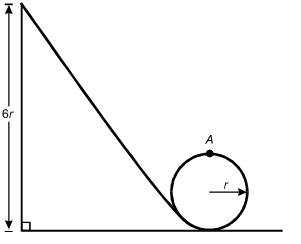
A mass initially at rest at a height of 6r slides down a frictionless track and around a circular loop of radius r. What is the speed of the mass at the top of the circular loop (point A)?
- Enter to expand or collapse answer.Answer expanded
- Correct Response: D. Since there are no frictional forces, the work done by friction is zero and the total mechanical energy is conserved. Therefore, mg(6r) =
 mv2 + mg(2r). Solving this equation for v gives v =
mv2 + mg(2r). Solving this equation for v gives v =  .
.
Competency 0007
Understand properties of the electric field.
7. Use the diagram below to answer the question that follows.
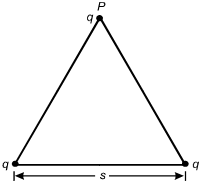
Three identical point charges are located on the vertices of an equilateral triangle of side length s. What is the vertical component of the electrostatic force on the charge located on vertex P?
- Enter to expand or collapse answer.Answer expanded
- Correct Response: D. From Coulomb's law, the magnitude of the force on q from the leftmost charge on the base of the triangle is F =
 , and the component in the vertical direction is
, and the component in the vertical direction is  cos θ, where θ = 30°. This force points in the positive y-direction. The same applies for the force from the rightmost charge. The net force is the superposition of the two forces, which is F =
cos θ, where θ = 30°. This force points in the positive y-direction. The same applies for the force from the rightmost charge. The net force is the superposition of the two forces, which is F =  cos 30°.
cos 30°.
Competency 0008
Understand properties of the magnetic field and electromagnetic induction.
8. Use the diagram below to answer the question that follows.
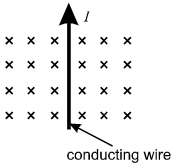
A wire that carries conventional current I in the direction shown is in a magnetic field that points into the plane of the page. Which of the following arrows shows the direction of the force on the wire?
- Enter to expand or collapse answer.Answer expanded
- Correct Response: C. The diagram shows a magnetic field that points into the page. The wire carries conventional current, which implies positive charges moving toward the top of the page. Since F = Iℓ × B and ℓ represents the direction of the conventional current I, the right-hand rule can be used to cross v into B. This shows that the force on the wire points to the left, as shown in response C.
Competency 0009
Understand properties of electric circuits.
9. A resistor is connected in series across the terminals of an ideal battery of voltage V. The resistor dissipates power W from the battery. A second, identical resistor is connected in series with the first resistor. What is the total power dissipated by the two resistors?

- W
- 2W
- 4W
- Enter to expand or collapse answer.Answer expanded
- Correct Response: A. The power dissipated by the resistor in the circuit is given by P = IV = W, where I is the current through the resistor. When a second resistor is added to the circuit, the effective resistance doubles. Since the voltage of the battery is the same, the current is
 I. Since there are two identical resistors in the circuit, the voltage across each is
I. Since there are two identical resistors in the circuit, the voltage across each is  V and the power dissipated by each is P =
V and the power dissipated by each is P =  W. Therefore, the total power dissipated is P =
W. Therefore, the total power dissipated is P =  W, or
W, or  .
.
Competency 0010
Understand the fundamental properties of waves.
10. A person standing 85 m from a wall shouts and hears the echo 0.50 s later. The person then plays a note of 440 Hz on a flute. What is the wavelength of the note in air?
- 0.39 m
- 0.77 m
- 1.3 m
- 2.6 m
- Enter to expand or collapse answer.Answer expanded
- Correct Response: B. Since the person hears the echo of the shout after 0.50 s, the speed of sound is 170 m/0.50 s, or 340 m/s. Since v = fλ, the wavelength is λ = 0.77 m.
Competency 0011
Understand the characteristics of light and electromagnetic radiation.
11. A light-emitting diode (LED) on a consumer device emits 0.020 W of light of wavelength λ = 650 × 109 m. Which of the following expressions equals the number of photons emitted by the LED per second in terms of Planck's constant (h) and the speed of light (c)?
- Enter to expand or collapse answer.Answer expanded
- Correct Response: A. The energy of a single photon is given by E = hf. For light, c = fλ, so E =
 . Since the power of the LED is 0.020 W, dividing the power by the energy of a single photon gives the number of photons emitted per second.
. Since the power of the LED is 0.020 W, dividing the power by the energy of a single photon gives the number of photons emitted per second.
Competency 0012
Understand thermal energy and the kinetic theory of matter.
12. Use the diagram below to answer the question that follows.
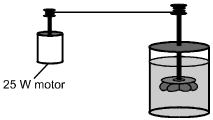
A closed, insulated vessel consists of a paddle wheel immersed in 0.50 kg of water at room temperature. The shaft of the paddle wheel is attached to a motor that has an output of 25 W. The paddle wheel rotates, churning the water. Disregarding the heat capacity of the vessel and paddle wheel, what is the change in temperature of the water if the motor is run for 5.0 minutes?
- 0.03°C
- 1.0°C
- 1.8°C
- 3.6°C
- Enter to expand or collapse answer.Answer expanded
- Correct Response: D. The first law of thermodynamics states that ΔE = ΔQ – W, where W is the work done by the system. Since the vessel is insulated, ΔQ = 0. Therefore, ΔE = W, since work is done on the system as the paddle wheel churns the water. Therefore, cwmwΔT = (25 W)(5 min)(60 s/min). Using the value cw = 4.19 × 103 J/(kg°C), which is given in the pages of constants and formulas, and solving gives ΔT = 3.6°C.
Competency 0013
Understand the fundamental principles of modern and nuclear physics.
13. Use the diagram below to answer the question that follows.
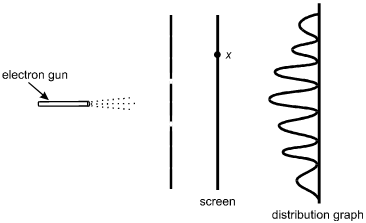
Electrons from an electron gun pass through a double slit before striking a screen. A counter records the number of electrons that arrive at the screen as a function of x, the position along the screen. The distribution of the number of electrons arriving is shown. According to the principles of quantum mechanics, the distribution pattern shown is a result of:
- electrons interfering due to their wave properties.
- electrons striking the edges of the slits while passing through.
- photons interacting with each other on either side of the slits.
- electrons interacting with photons before arriving at the screen.
- Enter to expand or collapse answer.Answer expanded
- Correct Response: A. In the double-slit experiment shown, the distribution of the number of electrons arriving at the screen at various positions is a result of interference. Interference is a consequence of the wave properties of electrons.















